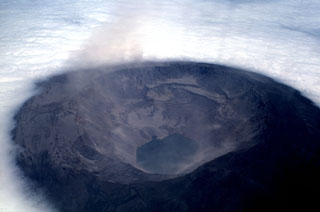Report on Fernandina (Ecuador) — 30 August-5 September 2017
Smithsonian Institution / US Geological Survey
Weekly Volcanic Activity Report, 30 August-5 September 2017
Managing Editor: Sally Sennert.
Please cite this report as:
Global Volcanism Program, 2017. Report on Fernandina (Ecuador) (Sennert, S, ed.). Weekly Volcanic Activity Report, 30 August-5 September 2017. Smithsonian Institution and US Geological Survey.
Fernandina
Ecuador
0.37°S, 91.55°W; summit elev. 1476 m
All times are local (unless otherwise noted)
IG reported that increased seismicity at Fernandina was detected at around 0955 on 4 September. Based on accounts from Galapagos Park personnel and photos of the volcano, an eruption started at around 1225. The Washington VAAC reported that lava was detected in satellite images beginning at 1230; a steam-and-gas plume rose 2.4 km (8,000 ft) a.s.l. and drifted almost 60 km W. At around 1428 IG noted that an eruptive plume was identified in satellite images rising 4 km above the crater and drifting NW. The VAAC reported that on 5 September a plume likely composed of sulfur dioxide and water vapor, and possibly some ash, rose to 2.4 km (8,000 ft) a.s.l. and drifted SW. There are no residents on Fernandina.
Geological Summary. Fernandina, the most active of Galápagos volcanoes and the one closest to the Galápagos mantle plume, is a basaltic shield volcano with a deep 5 x 6.5 km summit caldera. The volcano displays the classic "overturned soup bowl" profile of Galápagos shield volcanoes. Its caldera is elongated in a NW-SE direction and formed during several episodes of collapse. Circumferential fissures surround the caldera and were instrumental in growth of the volcano. Reporting has been poor in this uninhabited western end of the archipelago, and even a 1981 eruption was not witnessed at the time. In 1968 the caldera floor dropped 350 m following a major explosive eruption. Subsequent eruptions, mostly from vents located on or near the caldera boundary faults, have produced lava flows inside the caldera as well as those in 1995 that reached the coast from a SW-flank vent. Collapse of a nearly 1 km3 section of the east caldera wall during an eruption in 1988 produced a debris-avalanche deposit that covered much of the caldera floor and absorbed the caldera lake.
Sources: Instituto Geofísico-Escuela Politécnica Nacional (IG-EPN), Washington Volcanic Ash Advisory Center (VAAC)

